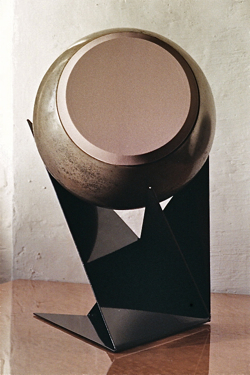Why Concrete?
If music was my life's blood, I needed better arteries.
Years of listening to the timber in loudspeaker enclosures on the retail shop floor, even in good loudspeakers, persuaded me that timber was not good enough. I could hear it and feel it, and I began in my mind to move timber out of the loudspeaker enclosure equation. In fact, timber in a loudspeaker enclosure is likely to run counter to the goal of excellent reproduction of music because of its softness and resonance. Timber adds colour to the sound, which you want when making acoustic instruments: you don't want these same resonant properties when making a loudspeaker enclosure.
In the late 1960s, early 1970s, I was reading in magazines that enclosures built of sand-filled timber panels were more inert. Other enthusiasts had adapted clay pipes to form an enclosure, but neither was very thrilling aesthetically. If resonance associated with timber was a problem, what material was preferable?
Discovery of the work of Harry Olson and of Dr. Richard Small, within the same 12 month period, coincided with a particular fascination with concrete, or, more accurately, the composite aggregates that produce concretes. I can actually remember looking at Olson’s graphs and saying to myself, ‘Why not a sphere? What material - non resonant - would be appropriate for the making of a sphere? CONCRETE!’
Previously, I had mixed and poured concrete for footpaths paths. Surely a sphere wouldn’t be too hard?
I will not describe the mess I got into-I will never forget it. But I won! It was 1971 and I had two concrete spheres of 4 cubic feet. These sealed enclosures contained an 11" Janszen bass unit in an acoustic suspension design, with the middle and high frequencies handled by the Janszen electrostatic plates, all driven by two amplifiers through an electronic crossover.
The results: they worked! They looked awful, showing my lack of skill, but the sound was galvanising and also mystifying: definitely different. There was an increased sense of space to the music I was used to using in critical listening. You couldn't really tell where the sound was coming from yet the image was rock solid. It was beautifully detailed and full and the depth of the soundstage was wonderful.
Walking Into The Music
Nonetheless, part of me kept thinking that something was missing. Eventually I realised that what I was missing was the resonance of a timber enclosure—that all too familiar warmth so often talked about as 'good'. What I had instead was sound that was neutral and lacking that additional colour. It sounded much more like what I heard at concerts. I tested it over a wide range of music. The sound was an excellent beginning, but only a beginning: there was much more to be had.
I soon found that there was more in the world than Portland cement. By 1983, I was experimenting with enclosures made from glass-fibre reinforced concrete [GRC] poured into a double mould, a technology new to me. It took quite some time to become familiar with it, and it involves an expensive production process, beyond the requirements of all but a few.
Meanwhile, involvement at the ANU School of Art led me to regularly visit the sculpture workshop. Some of the sculptors were working with types of alumina cement, a very different material to glass-fibre reinforced concrete. The finishes achievable with this material in a handbuilt application indicated an excellent alternative material, with excellent mechanical properties. Alumina cements are the mainstay of current Sophera enclosures, aided by sophisticated design, moulding, and finishing techniques.






